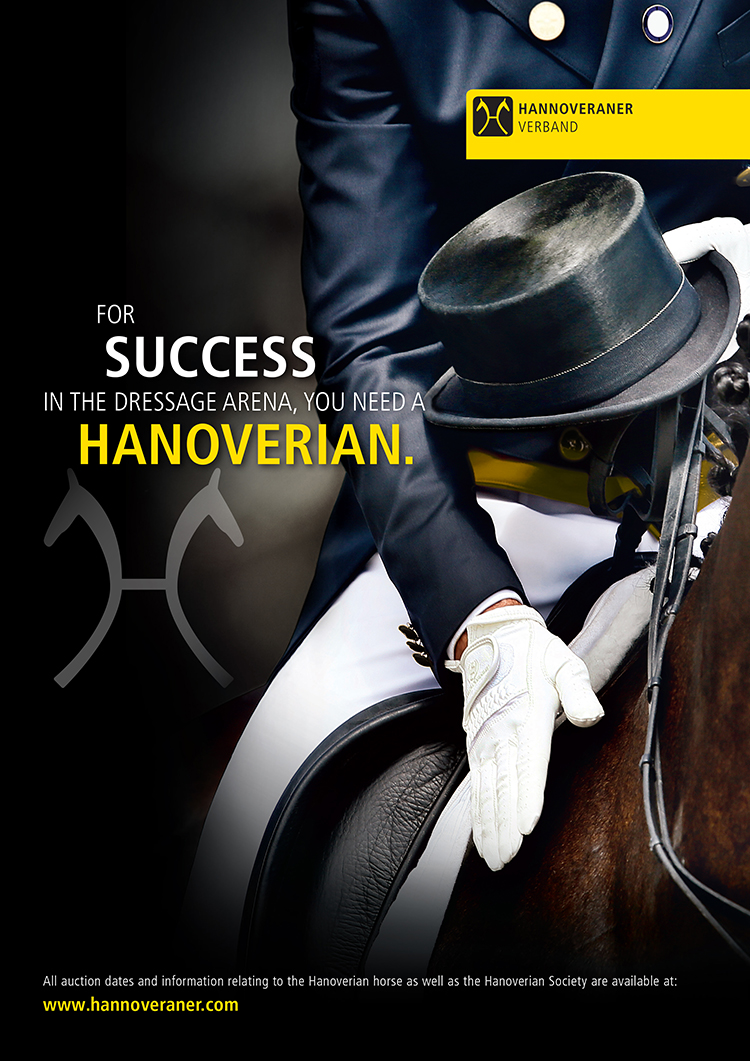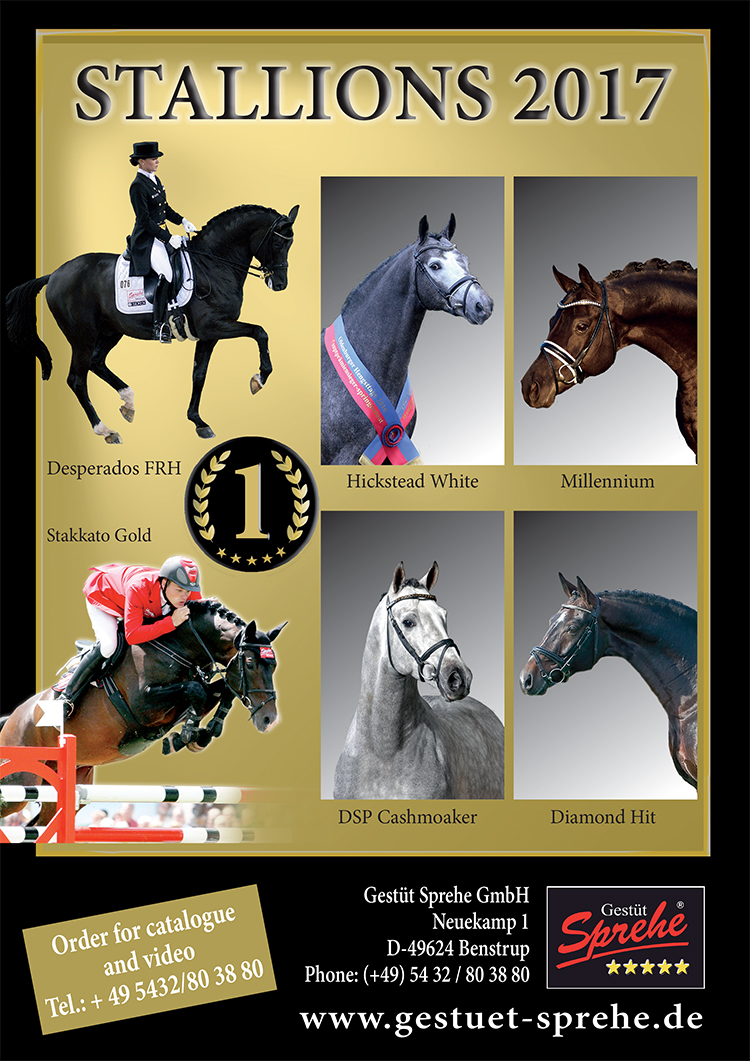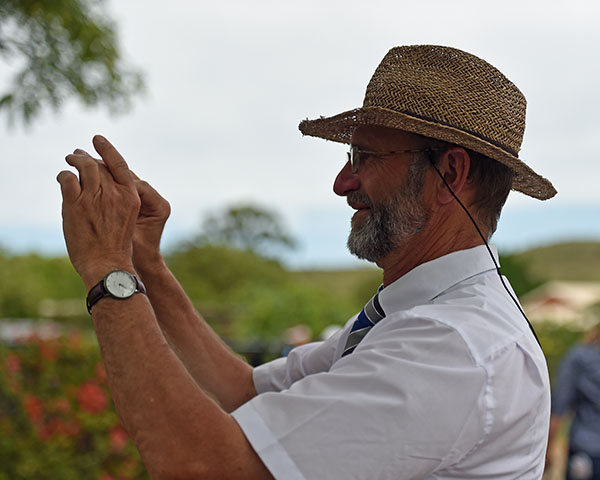
Christopher Hector interviews Dr Ludwig Christmann, head of the Hanoverian Verband’s Department of International Affairs, Development and Education.
Ludwig Christmann was our introduction to German horse breeding, and the Hanoverian breeding district. The Hanoverian Verband led the way in so many ways, and public relations was one of them. A key part of the Hanoverian publicity program was their study tour, and back in 1991, when we signed up for our first tour, the guide was a personable young man, Ludwig Christmann.
Back then Germany was a far more formal society; there was Herr This (or better Herr Doktor) and Frau that (although we didn’t meet many Fraus – on our tour of the little stallion stations, the ladies tended to stay in the kitchen while the gentlemen wined and dined us.) It didn’t take long before the American ladies in our group had dubbed him ‘Luddy’ as they pleaded with him for just one more Tack Shop stop. (if you’d like to read the two articles that arose from this tour, here is part one, and here is part two – you might be amazed at how quickly things have changed!)
Since then Ludwig has become a dear friend, and a wonderful resource as I battle to get my head around the finer points of German breeding. It was helped a little when he started coming to Australia as the Verband’s representative to classify horses in the Australian Hanoverian Society. Most recently, Ludwig combined classifying with a visit to his daughter (and new grand-daughter) who lives in Brisbane, which explains why the two of us are sipping second rate coffee in an airport ‘bistro’.
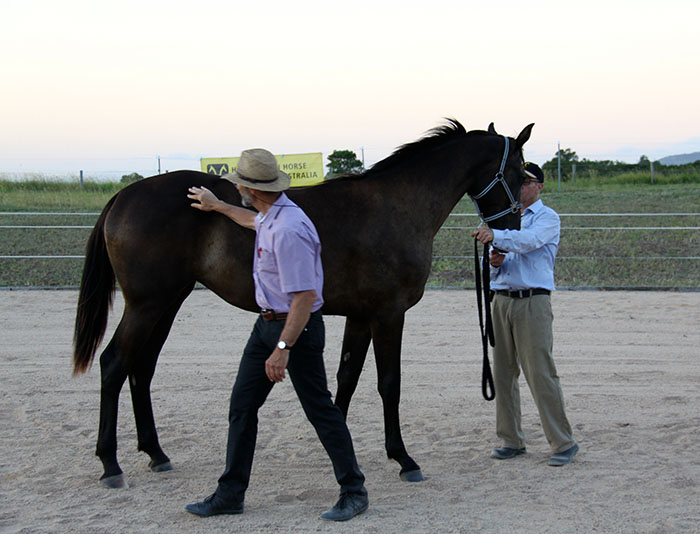
Times have changed, now Ludwig gets to inspect fillies by fashionable German sires… like this one by Desperados
more follows
How long have you been coming to Australia?
“Fifteen, maybe twenty years, I’m not so good with dates…
Has the look of the ideal Hanoverian worldwide changed over the past 20 years?
“I think it has changed a little bit. The horses are a bit longer in the leg, but it is not just the look, it is also the way the horses move and how they use themselves, that has changed over the last 20 years. Nowadays our horses are basically more balanced, they are more active in their movement. Looking at the dressage horses, the dressage riders want more freedom in the shoulder without losing the active hindleg – of course we breed for the market and have to know what the riders want.”
But this has led, as we see this year, where for the first time the German FN has split the breeding values into sires of young horses, and sires of top competition horses, to two types of horses, two sets of stallions producing a different ‘product’, do we now have two sets of conformation criteria?
“No, I don’t think so. The problem we have with sport horse breeding is that the horses reach their peak performances when they are 13 or 14 years old, but we want to use the younger generation of stallions. So we performance test the young stallions at three or four years old. The talent gets detected, but it is very difficult to say, okay, this four-year-old stallion will be a Grand Prix Dressage horse in the future, or this jumping stallion will one day win the Grand Prix of Aachen. It’s much more difficult than in the racing world where racehorses have their peak performances between three and five.”
“The old system for the breeding values took everything into account – I think it was a good idea to put together the stallion performance test, the mare performance tests, young horse classes and competition results to get the breeding value. The information from the competitions is the tricky one, because the competitions are not designed to performance test horses, they are made for the sport, and there is a problem in that there is so much pre-selection to decide which horses get to compete and go to the top. Compared to the data from the lower level classes, the data that comes out of the higher level classes is relatively small, we have low heritability for sport in high competitions, and this is why in the past when both levels were in the same breeding value calculation, the result was very much dominated by the results from the young horse classes.”
For more information on the new system of breeding values click
“I think the two breeding values is an advance, but the system is still not perfect. We have to work out how to best use the sport data for a breeding value. Another problem is to get the international data for the breeding values. At the moment the German Federation only uses German data, and the results from German riders who compete outside Germany. These are problems we have still to work out.”
“The basic question is what makes a Grand Prix dressage horse? Why is it so often that you say, that is a Grand Prix horse, but he would never win a young horse class, or a performance test. But then you see a horse like Desperados – he is a super modern horse, so a Grand Prix horse doesn’t have to be big and clumsy.”
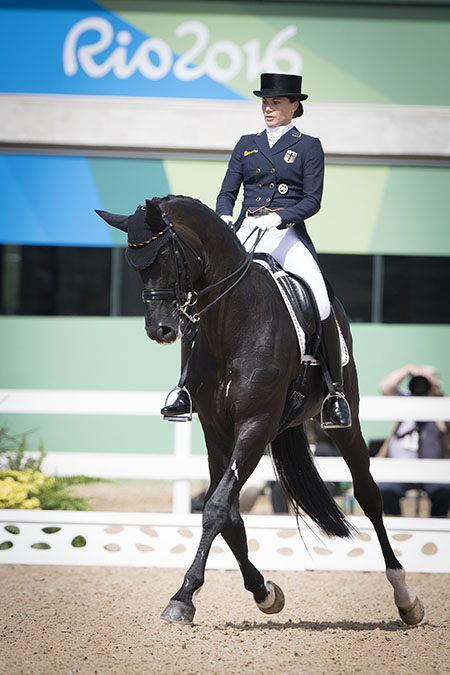
Desperados – super modern
Not big and clumsy, but certainly Desperados would be in a minority when we look at the top 30 GP horses in the world – most of them are shorter legged, shorter coupled… more like Valegro, stronger through the body…
“But Valegro still has three very good gaits, I don’t know the history, but he is a horse that would do well in young horse classes…”
No, no, he failed at the licensing, he was no young horse star…
“Okay.”
more follows
To become a top international jumping stallion, you have to produce 30, 40 international competitors – with the exception of De Niro, the top dressage horses have produced a handful of competitors, is that because dressage breeding is more recent, and hasn’t been consolidated the way jumping breeding has been? Or is dressage ability less inheritable than jumping ability?
“It is also a matter of numbers, we have a lot less dressage competitions all over the world. Jumping is much more developed and popular around the globe. I do think that jumping ability is more heritable, but also you can more easily detect jumping ability when the horse is young. At an early age you can see that the horse has scope, is careful and so on. I’m not a dressage trainer but I think that the predictability for piaffe / passage, is difficult when the horse is still young.”
So the test in a young jumping class is much the same as the test in a 1.60m class…
“Not totally, but it is easier – the development is much more linear. You have many dressage horses that are very good up to a St Georges level, but the jump to Grand Prix is beyond them. When you look at the pedigrees nowadays, you see that the talent for piaffe and passage is also inherited.”
And you see that the most successful dressage stallions are the ones that have competed Grand Prix themselves…
“The really sophisticated dressage breeders, if they want to breed a Grand Prix horse, they take a stallion that has competed well in Grand Prix or a promising young stallion with ‘Grand Prix blood.’ It’s the same in jumping, when you look at the top list of jumping horses, you see that most of their sires have been successful at 1.60m level. At this highest level of competition, it is very demanding, it is not only the technique or the scope, the horses have to have the mentality and soundness, it takes a lot for a horse to compete at that world class level. These qualities are not so visible in the beginning but they are important at the end. This is true for dressage and showjumping.”
“Look at Fine Lady, when Eric Lamaze bought her, even though she was winning in 1.50m classes, no one thought she would be an Olympic horse. Even at that level, you can still be surprised by a horse. Maybe she is not jumping with a perfect style, she always jumps that much higher than she needs to, no matter if the poles are at 1.20m, or 1.60m. What I am saying is that the horse has to have a winner’s mentality.”
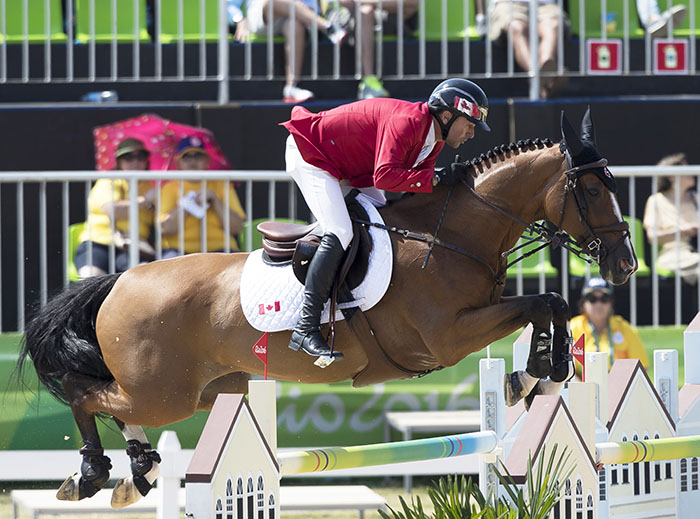
Fine Lady by the For Pleasure son, Forsyth FRH – Furioso again
That has been a gold mine for Hanover, the blood of For Pleasure…
“It’s amazing, but it is also an example of exactly what I am saying, as five-year-olds you can see their talent, but they develop as the fences get higher. For Pleasure himself had his own jumping style and he passed that jumping style on to his offspring but he also passed on the soundness and the hardiness and the reliability.”
Is it significant that For Pleasure was himself an Olympic Games, 1.60m star, whereas a horse like Stakkato was never a star at that highest level, and he seems to produce horses that are nice and rideable, but not international stars…
“I think that is making an unfair comparison at the moment because you are playing one against the other…”
But that is what we do as breeders, we say do I want a nice rideable 1.40m horse that an amateur can ride, or take the risk to get a superstar, and we compare the stallions and decide which is more likely to give us the result we want….
“They are very different styles of stallions, but breeding is always an evolutionary process. Stakkato gives a lot of great qualities to his offspring: carefulness, technique and so on, and we are seeing some very promising sons of him that have produced horses that are competing internationally. At the moment we have Super Sox by Salito, also Stakkato Gold is producing very promising progeny, and he is strong on both sides, his mother by Werther, was a 1.60m jumper herself.”
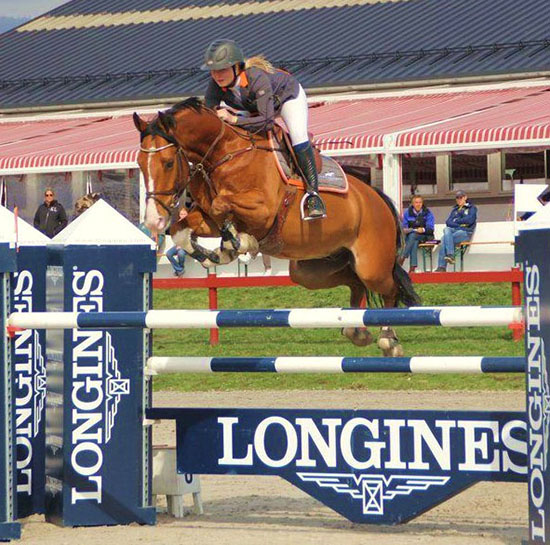
Super Sox – by Salito by Stakkato
“I think we will see that Stakkato and his sons are giving something significant to the international jumping world.”
Did you expect that For Pleasure would become such a valuable sire?
“When the first For Pleasures were five and six, they were not the sort of horses that would go to the Bundeschampionate. They were not highly rated at the time, but I am very happy that For Pleasure has proven that it is never too late for a stallion to come back.”
For Pleasure is also the return of Furioso II, and yet for a while it looked as if his ‘F’ line had disappeared…
“I would not say disappeared, at the moment I would say the Furioso line is the most influential line in modern sporthorse breeding. In dressage, we see what evolves from this line. In jumping, Kannan is a son of the Hanoverian Voltaire by Furioso, Ferro, Jazz, Florestan – all coming from this line. It is amazing this line became so successful.”
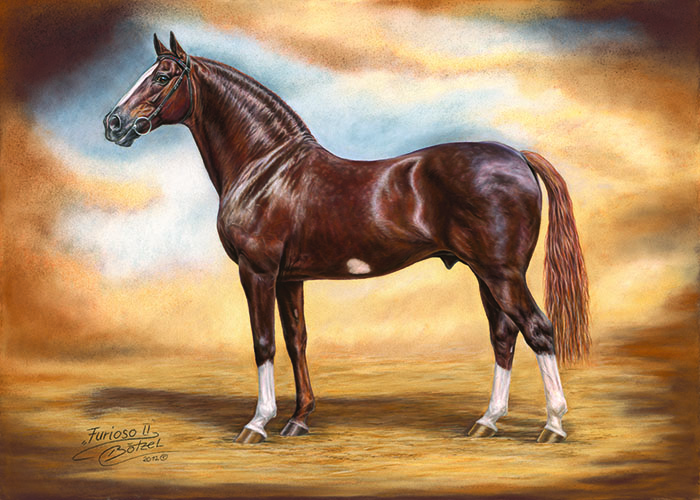
Furioso II – the most influential sire right now. Painting: Christina Bötzel
http://www.atelier-boetzel-eberl.de/shop/portraits/english.html
Mr Vorwerk must have had a great ‘eye’, to go to France and come back with something as good as Furioso II…
“I did not know him well. I met him a couple of times, and he was an outstanding animal breeder, he was also an outstanding cattle breeder, and he had a very good eye for a horse. It was not only Furioso II himself, there was also the full-brother, Mexico, who went to Holland. It is their sire, Furioso xx, the Thoroughbred, who has been so influential. It was the same in Holstein with Cor de la Bryère and Maas J. Hell. There are individuals who are very good horse people and they find stallions that really change the breeding.”
But it is so often the out-cross stallion – you bring a Selle Français horse to Holstein, and suddenly you get these great jumpers, or you bring another Selle Français to Oldenburg in the form of Furioso, and suddenly we get a line of dressage horses and jumpers. Is finding that radical outcross very important?
“It is a known effect in animal breeding, the hybrid effect, when you have two populations that are not related to each other, then you get a product which is better than the average of the two. The question then becomes how to continue on with this process…”
Haven’t we got to the stage where the chance of the radical outcross has almost disappeared as people breed more and more mares to fewer and fewer stallions? They breed to the fashionable stallions and they are all of the same bloodlines… Once Dr Bade could say to the breeders, here is an ugly little chestnut called Grande, use him – and the breeders did. Now it is much harder to find the outcross…
“That is one side of the argument – on the other, do the breeders now have more possibilities than ever before? They can get any genetics in the world with frozen semen, and breeders have more access to more information through the internet.”
“There is always a big risk with these outcross breedings, it is inherently unpredictable and many times, it does not work. I think a breeding strategy which is based on dam lines, good damlines that have produced sport horses, and you combine this with stallions that were top in the sport, this for me is a more promising strategy than the outcross.”
It’s harder with dressage than jumping to find an outcross – if you are breeding jumpers in Germany you can go to France, or Holland, or Belgium… but it is harder to find proven dressage stallions, for German breeders there is nowhere else to look…
“There are now stallions in The Netherlands, and that is why our breeders are looking to our neighbours in Holland.”
Do you personally think that is going to be a successful strategy? When I look at Dutch breeding, the strategy in terms of producing horses for top level dressage has not been so successful. Will breeding to horses like Vitalis, who has never competed Grand Prix, be a success, doesn’t that go against your principle that the good sires are the ones that have competed at the highest level?
“There are reasons why some Dutch stallions have been popular. When we look at the pedigrees of some of these stallions, there are some Grand Prix horses in the pedigree. When you look at Vivaldi, the sire of Vitalis, he has Jazz in his pedigree.”
“I think what we get from the Dutch horses is a good push from the ground, and we get an impressiveness in the front. I think to some extent the Dutch have a different philosophy of the horse – how the horse should function – and I think it is good when we use some of the power of the Dutch horses. But we also have to combine it with the strengths of our Hanoverians – suppleness, rideability, temperament. I think there are some benefits in the Dutch horses, but I think there are a lot of benefits in our horses and we have to see that we get the best from the Dutch without losing our advantages.”
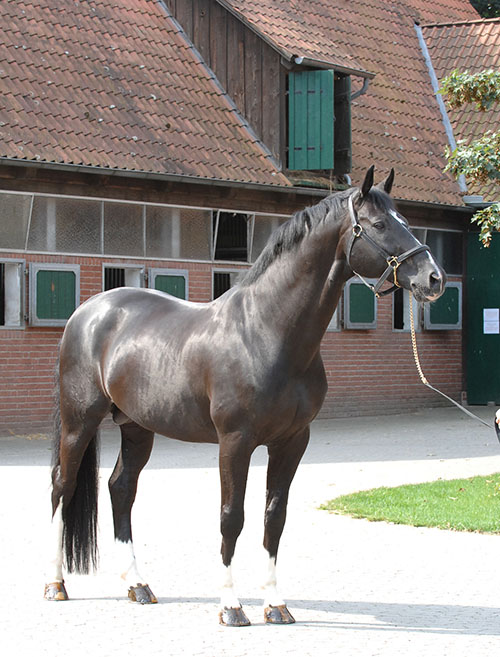
De Niro – an extraordinary sire
What makes De Niro such an extraordinary stallion? Yes, he has been well promoted, but there are a lot of other sons of Donnerhall out of mares as good as the dam of De Niro, that have been well promoted, but they haven’t produced anything like the number of international performers that De Niro has produced…
“I think you should probably talk to the riders and trainers, I think it is the minds that they like. When I talk to Mr Sprehe about Desperados and he says the horse is always fit, even if it is 35 degrees like in Rio, he always does his job. They have the talent for collection and the higher movements, but it is the mind that makes them so special.”
Are there any young dressage stallions on the scene that might one day be up there with De Niro?
“I don’t think we can forecast this. I think there are some very good young stallions coming up, but you can’t predict that one will be a dominating stallion in the future. Interesting stallions at the moment include Benicio, and Quantensprung who had such a great crop at our stallion licensing. All five of the selected sons were licensed, three were named premium stallions and all three of them became the best sellers of the auction.”
See the top priced stallion at the Auction, by Quantensprung out of a Fidertanz mare in action here:
https://www.youtube.com/watch?v=VJc8iqAOfnk
“For me the D line is still the most important dressage line and there are some good young D stallions, for example Destacado who starred at the Bundeschampionate last year, he’s a very exciting young horse, and he is in the right hands. We really have some young stallions with three very good gaits, walk, trot and canter, horses that are highly rideable, and with Grand Prix blood in their pedigrees.”
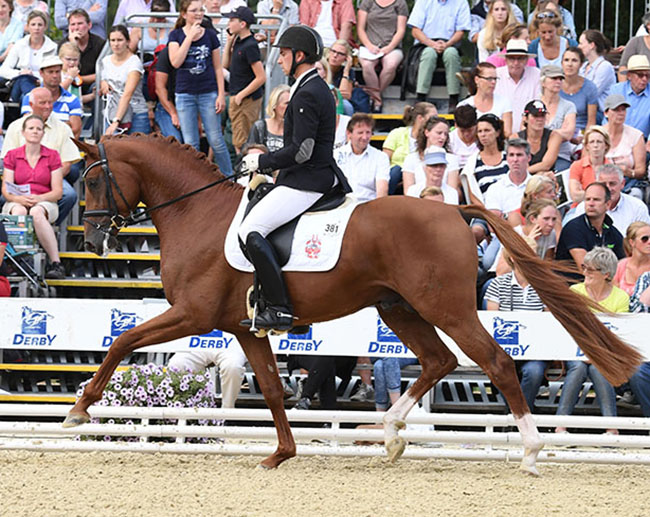
Destacado, an exciting young stallion (Photo Kiki Beelitz)
The B line faded for a while but it has made a real come back as a strong force…
“For this, you need a star, and it is never predictable which sire will become a star. When you look at the breeding programs, you are looking for the talents, but the prediction, which stallion at the end will be a superstar, that is very difficult.”
Breitling has been an amazing producer of Grand Prix horses, but I remember talking to one of the KWPN stallion commissioners, and he said, oh we couldn’t use Breitling, he is too old fashioned – maybe that’s why their licensing stars are not going on to compete Grand Prix or sire Grand Prix…
“Of course the success of Breitling was very much connected with the success of Wolfram and Brigitte Wittig, but the horse still has to be able to do it, it’s not just the rider. Breitling was a super stallion, and of course, from that line, Belissimo, and more recently Benetton Dream. Those three stallions gave the B line the big push.”
Is there anything left of the F line that is important?
“There are many interesting young stallions, for instance Foundation looks very promising.”
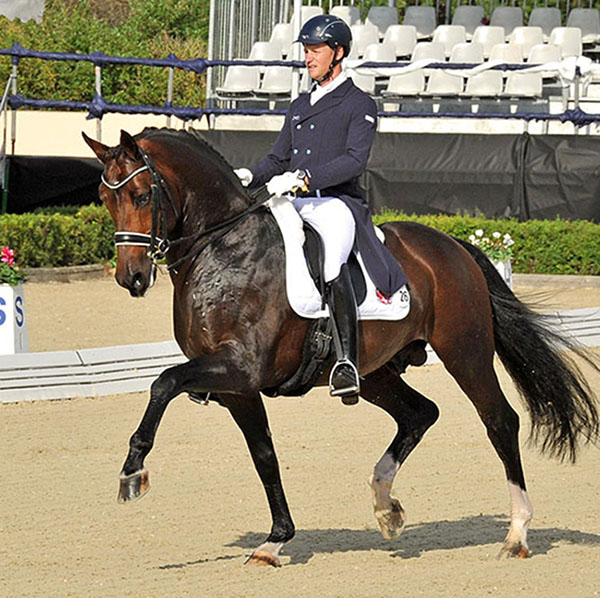
Foundation – promising
Not just a young horse sire?
“We don’t know yet, but he himself is very successful in competition, and he also has enough De Niro blood in his pedigree. There are many promising young stallions.”
Continues below the advertisement

presents FOUNDATION
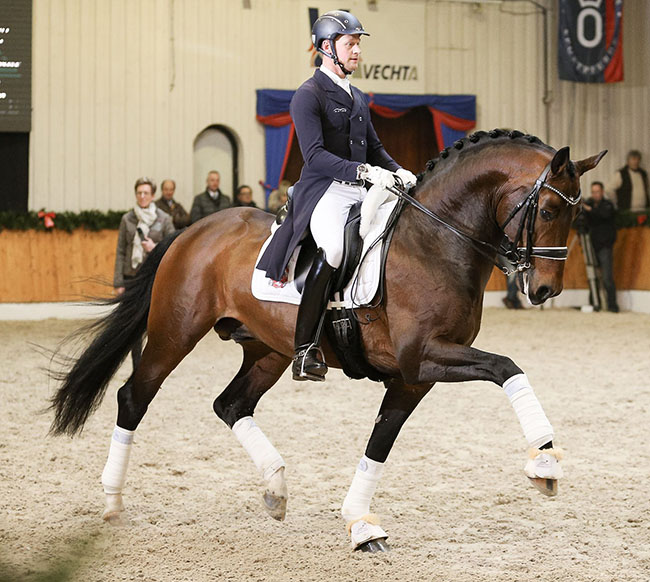
Florestan and De Niro combine in one super modern, exciting package. Tipped to be Matthias Rath’s next Grand Prix star, Foundation is the choice of knowledgeable breeders looking for dressage talent, rideability and good looks.
FOUNDATION Price Semen 3 ins $1530 & Agents Fee $296 & GST= Total $2010
Contact Glenis Dyason on (03) 5439 7251 or 0427 400 357 / sales@ihb.com.au www.ihb.com.au
Which young jumping stallions are emerging?
“Stakkato Gold is still very promising. He shines in many international analyses as a very promising young stallion. At the State Stud, Diacontinus had a very good first year at the stallion licensing and we have high hopes for him. Grey Top is a promising stallion from our old ‘G’ line… but as we have seen, they have to go step by step before they establish themselves.”
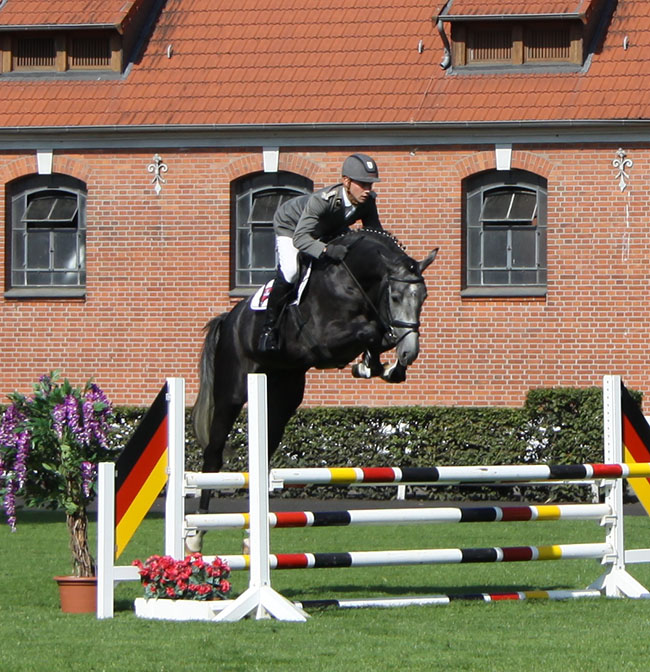
Diacontinus – by Diarado
When I first came to Hanover, the 100 day test was the Holy Grail, now it seems it will disappear because all the stallion owners want to do the new three day test…
“At the end of the day, we are aiming to find the best talents for the sport. The 100 day test belongs to a time when the stallions were not trained that well, and were not managed so professionally as they are now. When they came into the test there was not a lot of training, so you could follow the development through the hundred days. Now every stallion is in professional hands, and so the new tests are an attempt to say, okay the training is in the hands of the owner who has to present the stallion and prove his quality. That means we don’t have the training observation period any more… The idea of the new system was also to have it more discipline orientated, but the requirements within the discipline, are now higher than they were before.”
Interview continues after the advertisement…

presents DIACONTINUS
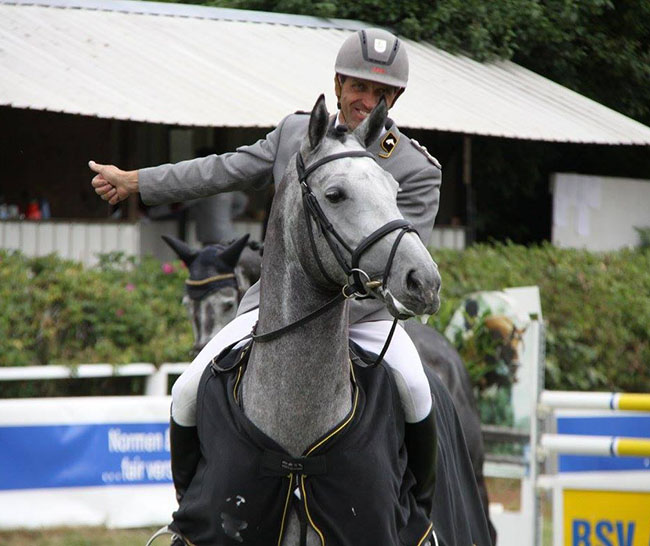
What a fabulous pedigree, the world’s number one WBFSH jumping stallion, Le Tot de Semilly over a mare by the great Corrado. This is the French / German combination that is setting the jumping world alight.
DIACONTINUS $4350.00 GST incl
Contact Glenis Dyason on (03) 5439 7251 or 0427 400 357 / sales@ihb.com.au – go to our website and you will find all the wonderful Hanoverian stallions at Celle
www.ihb.com.au
“It is expected, that the stallions are presented on the highest level according to their age in the same style as in the young horse classes. The jumping test is at 1.10 m for a four-year-old and a 1.20 m course for the five-year-olds, so they have to prove their trainability and their talent. For the dressage stallions they must show counter canter at the age of five.”
“There is also the 50 day test, which is the shortened version of the old 100 day test, and even a six-year-old stallion can go into this test. If he is a jumper, he has to jump a 1.30m course, if he is a dressage stallion he has to perform a lead change.”
But didn’t all the stallion owners decide to send their horses to the three-day test and there were no stallions at all entered in the 50-day test…
“No, the 50-day tests last Fall, in November, were full. Then they opened another 50-day test in January and there was no demand for this one. I think there will be good numbers for the 50-day tests next November. I still think it makes sense for the stallion owner to test the stallion as a three-year-old in the 50 day test – the three day alternative tests the stallion over three years, at three, four and five, and it is easy for a stallion to go lame, whereas once he completes the 50-day test, that’s it, he’s a licensed performance tested stallion.”
We met in the 80’s on the Hanoverian study course and there have been so many changes since then. I feel nostalgic for the little two, three horse stallion stations with the pub attached the centre of the community, and the stallion man all dressed up in this uniform. It was a rich local thing, and now it is more rich guys with lots of horses, buying chilled semen from anywhere…
“I think what was positive in those old days was that there was a community of horse breeders – and I think we still have such a community in Hanover. We have our breeding clubs, they organize meetings over winter and functions, so this is still alive, and this is a good base for us in the future. It is a problem that we have lost many of our farming-based breeders – this has to do with the structure of farming, and the trend towards bigger and bigger and more specialized farms. Many of our old breeders gave up farming and horse breeding and this is a loss, a loss of knowledge. We have new breeders who are very enthusiastic, and they are not only very rich ones with many horses, there are many dedicated new breeders who are not super rich.”
In the old days when the mare owners bred to the stallions at the local station, then you ended up with a mare band that was genetically very similar, so it was easy to see which mares a stallion crossed well with – that ‘breeding laboratory’ doesn’t exist any more…
“This is a result of AI and what I see as an advantage of AI is that the average stallion that is popular within the breed is of higher quality than in the days before AI. When we needed more stallions thirty years ago, the average quality was far lower than the stallions of today.”
Do you worry that less and less stallions are being used over more and more mares – do you worry about the effect on the gene pool?
“No, at the moment I don’t worry. There has been a lot of research in the Hanoverian breed looking at in-breeding, and in the Hanoverian population it is not a problem. The Hanoverian is not so much a closed breed, and we have the possibility to take in outside blood. There are still many genetic choices for the breeders.”
Turning to Australia, what changes have you seen in the horses in the 20 or so years you have been coming here to classify?
“The way the Hanoverian breeding base was started in Australia, with Thoroughbred mares, proved to be successful. It was too expensive at that time to bring in Hanoverian mares on a big scale. Breeding management discussed it at the time and said, okay we start with Thoroughbreds, but with a very selective program. Both Australia and New Zealand have a very good Thoroughbred mare base, which made the strategy work, we saw mares with good legs and good movement. This time I haven’t seen so many Thoroughbred mares in Australia, more in New Zealand, and in Australia, there are now more breeders who have imported mares.”

St Pr mare Remi Lady Godiva is congratulated by the classifiers, Ludwig Christmann and Kevin Lewis – photo Sue Crockett
“We had the filly importation program ten years ago, and many of these fillies have become successful sport horses, and are producing good foals already. The quality of the mare base has improved, and we are now seeing real Australian Hanoverian mother lines, based on Thoroughbreds, but now with four generations of Hanoverian stallions.”
Continues after the advertisement…
Expressions of interest sought from breeders…
The HHSA and the Hannoverian Verband would be in favour of coordinating a Filly Importation Program for jumper-bred fillies if breeders wish to express their interest.
There’s many benefits on offer, including advice and assistance from Verband classifiers to help you find the filly you want.
janette.lewis@live.com.au http://www.hanoverian.org.au

“When I looked at the Young Horse championships two weeks ago, I thought, the system has worked well here. It is a big point that not only in Australian and New Zealand does our system work, we see it also in England, in the USA. England has produced Farouche, a two times World Champion, there was a British bred Hanoverian on the British silver medal winning team last year, and there is an eventing horse by Don Kennedy that ranked in the top ten. In New Zealand, Wendy Williamson has qualified as the first New Zealand rider to go to a World Cup Dressage final, on a New Zealand bred Hanoverian The breeding program is working all over the world.”
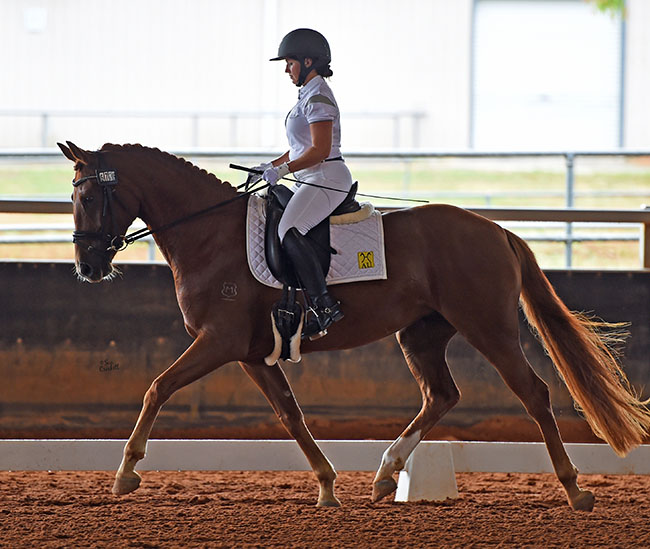
Photo shows Divine Miss Daisy M by Diamond Hit owned / bred and ridden by Clare Muller. Clare imported the dam Han Premium Mare La Bonita (imp) / Londonderry/Brentano 11 as part of the importation of fillies program.
Presents QUANTENSPRUNG
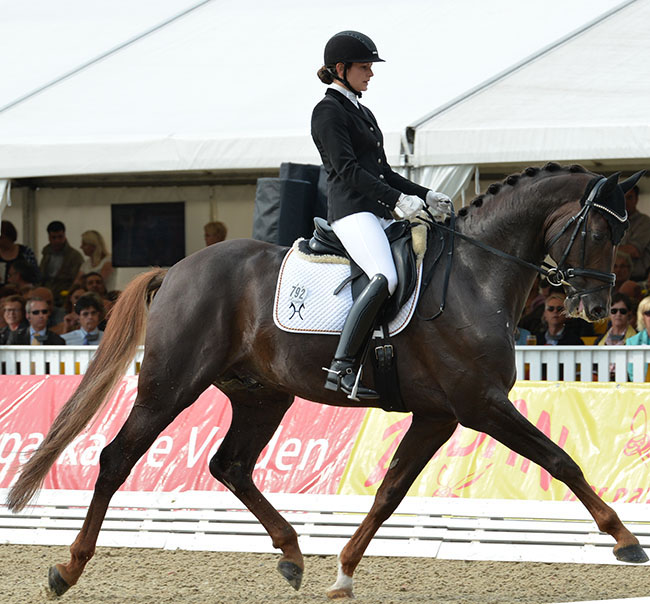
By the Olympic dressage star, Quando-Quando out of a mare by Donnerhall, Quantensprung is the hot young stallion on the Hanoverian dressage breeding scene…
QUANTENSPRUNG $1495 GST incl for as long as current stocks last.
(New price $1730).
Contact Glenis Dyason on (03) 5439 7251 or 0427 400 357 / sales@ihb.com.au – go to our website and you will find all the wonderful Hanoverian stallions at Celle
www.ihb.com.au
If you are interested in Sporthorse breeding, visit our Breeders Club – the world’s largest collection of Warmblood breeding articles and interviews…



